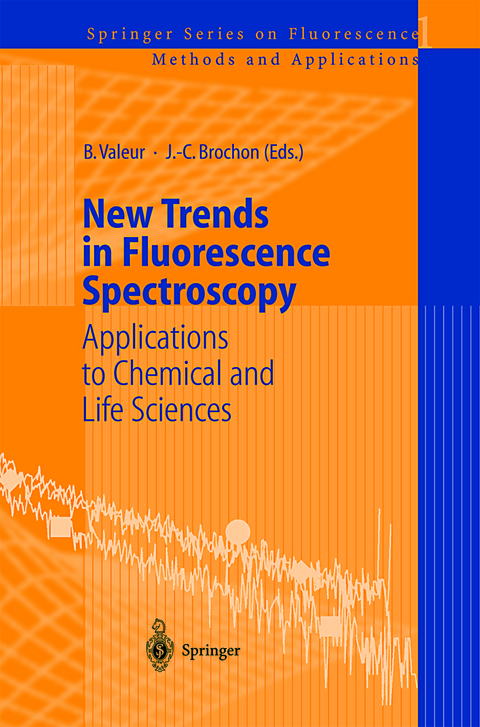
New Trends in Fluorescence Spectroscopy
Springer Berlin (Verlag)
978-3-642-63214-3 (ISBN)
1 Historical Aspects of Fluorescence.- 1 Introduction: On the Origin of the Terms Fluorescence, Phosphorescence, and Luminescence.- 2 Pioneering Contributions of Jean and Francis Perrin to Molecular Luminescence.- 3 The Seminal Contributions of Gregorio Weber to Modern Fluorescence Spectroscopy.- 2 Fluorescence of Molecular and Supramolecular Systems.- 4 Investigation of Femtosecond Chemical Reactivity by Means of Fluorescence Up-Conversion.- 5 Spectroscopic Investigations of Intermolecular Interactions in Supercritical Fluids.- 6 Space and Time Resolved Spectroscopy of Two-Dimensional Molecular Assemblies.- 7 From Cyanines to Styryl Bases - Photophysical Properties, Photochemical Mechanisms, and Cation Sensing Abilities of Charged and Neutral Polymethinic Dyes.- 8 Phototunable Metal Cation Binding Ability of Some Fluorescent Macrocydic Ditopic Receptors.- 3 Fluorescence in Sensing Applications.- 9 The Design of Molecular Artificial Sugar Sensing Systems.- 10 PCT (Photoinduced Charge Transfer) Fluorescent Molecular Sensors for Cation Recognition.- 11 Fluorometric Detection of Anion Activity and Temperature Changes.- 12 Oxygen Diffusion in Polymer Films for Luminescence Barometry Applications.- 13 Dual Lifetime Referencing (DLR) - a New Scheme for Converting Fluorescence Intensity into a Frequency- Domain or Time-Domain Information.- 4 New Techniques of Fluorescence Microscopy in Biology.- 14 Two-Photon Fluorescence Fluctuation Spectroscopy.- 15 Fluorescence Lifetime Imaging Microscopy of Signal Transduction Protein Reactions in Cells.- 16 New Techniques for DNA Sequencing Based on Diode Laser Excitation and Time-Resolved Fluorescence Detection.- 17 The Integration of Single Molecule Detection Technologies into Miniaturized Drug Screening: Current Status and FuturePerspectives.- 18 Picosecond Fluorescence Lifetime Imaging Spectroscopy as a New Tool for 3D Structure Determination of Macromolecules in Living Cells.- 5 Proteins and Their Interactions as Studied by Fluorescence Methods.- 19 About the Prediction of Tryptophan Fluorescence Lifetimes and the Analysis of Fluorescence Changes in Multi-Tryptophan Proteins.- 20 Application of Time-Resolved Fluorescence Spectroscopy to Studies of DNA-Protein Interactions and RNA Folding.- 21 Rare Earth Cryptates and TRACE Technology as Tools for Probing Molecular Interactions in Biology.- 22 Tracking Molecular Dynamics of Flavoproteins with Time-Resolved Fluorescence Spectroscopy.
| Erscheint lt. Verlag | 17.8.2012 |
|---|---|
| Reihe/Serie | Springer Series on Fluorescence |
| Zusatzinfo | XXV, 490 p. 211 illus., 4 illus. in color. |
| Verlagsort | Berlin |
| Sprache | englisch |
| Maße | 155 x 235 mm |
| Gewicht | 789 g |
| Themenwelt | Naturwissenschaften ► Chemie ► Analytische Chemie |
| Naturwissenschaften ► Chemie ► Physikalische Chemie | |
| Technik ► Elektrotechnik / Energietechnik | |
| Schlagworte | fluorescence • Fluoreszenz • Fluorimetrie • Laser • Microscopy • Mikroskopie • Sensor • sensors • spectroscopy • Spektroskopie • Supercritical fluid • Temperature • Tracking • Trend |
| ISBN-10 | 3-642-63214-9 / 3642632149 |
| ISBN-13 | 978-3-642-63214-3 / 9783642632143 |
| Zustand | Neuware |
| Haben Sie eine Frage zum Produkt? |
aus dem Bereich


